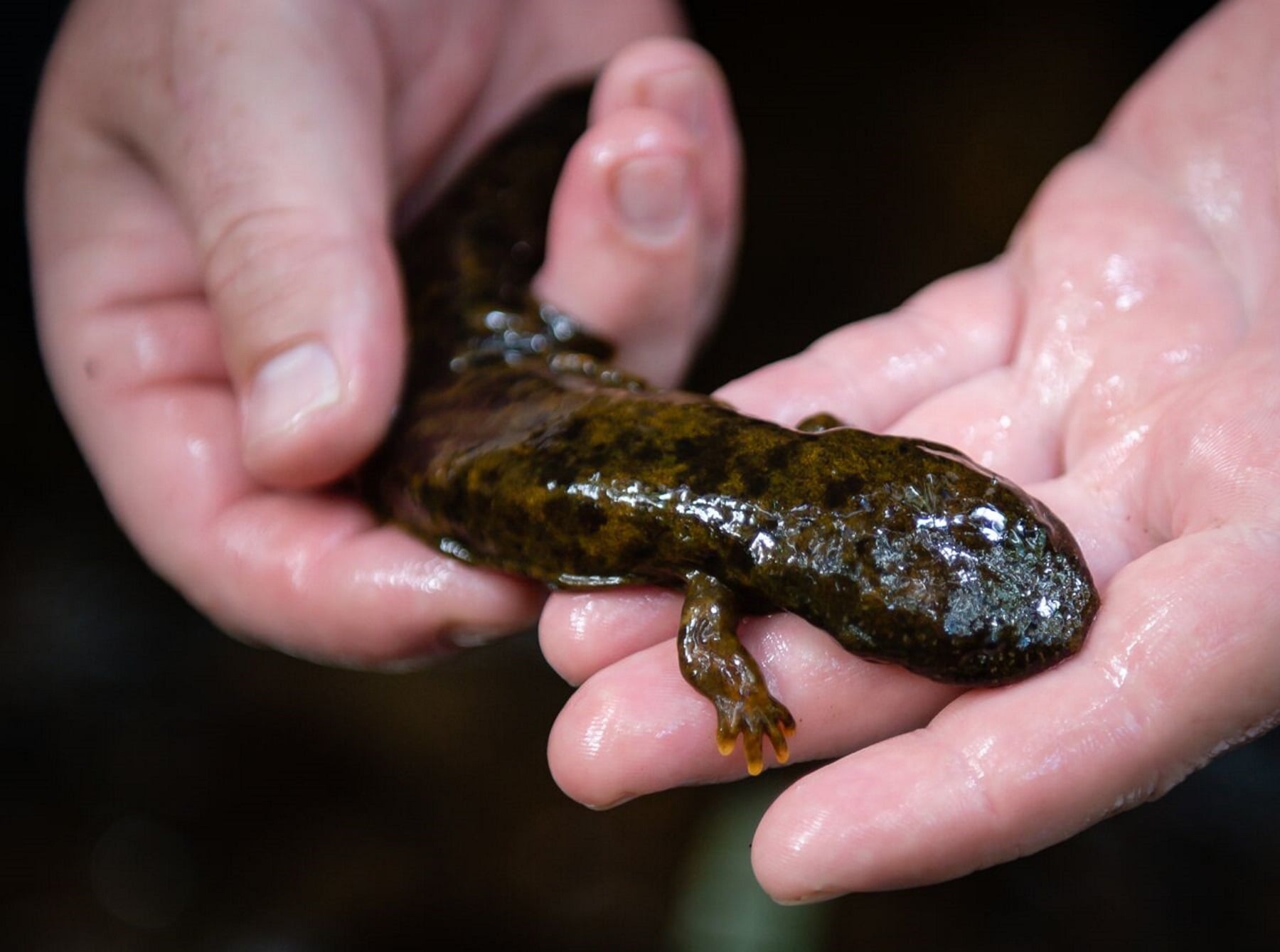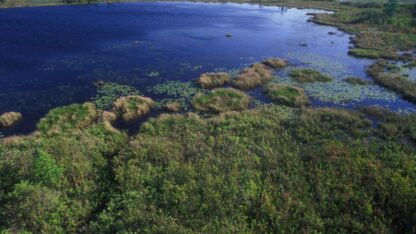In the deep woods of the Blue Ridge Mountains, a cold, clear stream flows. Below a canopy of twisted rhododendrons, seven people in black wetsuits creep upstream through the water. They look like Gollum, sleek in their neoprene, crouching in the water, feeling under rocks.
They’re looking for a kind of giant salamander known as a hellbender that lives in parts of North Georgia. Most people will probably never see one, but hellbenders are weird, rare and sort of beloved by people in the know.
Over the last few decades, scientists have come to realize that the big salamanders might be in trouble, and the federal government is now considering whether to protect them.
The wetsuit-clad researchers in the stream are from Georgia agencies – the Department of Natural Resources and the Georgia Department of Transportation – and they’re conducting a survey to get a sense of the state of the hellbender here.
Meet The Hellbender
Hellbenders are shiny, slimy animals. They can grow to nearly 2 feet long and might live as long as 20 or 30 years, spending much of their time underneath rocks in cold, clean streams. They have flat, round heads and a wide mouth that makes them look like they’re smiling. “A toothy sock puppet with frills,” is how one person described them to me.
”I don’t know that there’s a lot going on in a hellbender’s head. But it’s a face a mother and a herpetologist can love,” says Thomas Floyd, a wildlife biologist with the Georgia Department of Natural Resources who’s leading the survey.
Floyd calls hellbenders cute, then backs off on that a bit.
“Tiny, tiny eyes. They’re not furry, they’re not cuddly, they’re slimy. It’s the opposite of a cute kitten, I guess, but we like it,” he says.
And if the name hellbender isn’t good enough, they also have a bunch of other nicknames.
“I’ve heard a few, most common in this portion of the southern Appalachians is probably mud dog,” says Floyd.
There’s also snot otter.
He continues: “Water dog, grampus, grumpus, mollyhugger, horny head, devil dog.”
And finally, old lasagna sides, in recognition of the curvy flap of skin that runs down hellbenders’ torsos.
Snot Otter Success
The group here is looking for hellbenders because the species seems to be in trouble, so they’re trying to learn more about where they live and how they’re doing. In Georgia, they check streams every few years for hellbenders to get a sense of their demographics.
After just a few minutes of looking, they find one. It’s a young hellbender, which is especially exciting, says Floyd.
“It’s neat to see an adult, but it’s even neater to see a small juvenile,” he says.
That’s because in streams where hellbenders aren’t doing well, researchers only find the adults, meaning, for some reason, they’re not reproducing well, or the eggs or young salamanders aren’t surviving. A stream like that will eventually lose its hellbenders.
That’s not the case in this North Georgia stream, which, Floyd says, is still a great place to find hellbenders.
The researchers take measurements on the hellbender they’ve caught. He’s about 8 inches long, and probably 4 or 5 years old, says Floyd.
“He’s a juvenile for sure,” he says. “That means there’s been successful reproduction.”
But scientists say that across their range, hellbenders are in decline.
Devil Dogs In Trouble
“So historically, hellbenders occurred in about 15 states and probably across more than 500 streams,” says Bill Hopkins, a professor at Virginia Tech who studies hellbenders.
Their range generally covers the Appalachian Mountains, from southern New York to North Georgia.
Hopkins says researchers began realizing in the 1980s that hellbender numbers were dropping. Since then, they’ve figured out that about 40 percent of hellbender populations are either totally gone or about to be. Another 40 percent are declining.
“It’s really bad, and I think hellbender biologists across the nation would agree with that,” Hopkins says. “That’s something that we’re all really, really worried about, and we’re trying to understand what the causes are.”
The biggest problem for hellbenders is damage to those clean streams they live in; when forests get cut down, or roads are built, or an area gets developed, that can pollute or silt up a stream and make it bad for hellbenders.
Sometimes people intentionally kill hellbenders, so that’s a problem, too. Disease could be an issue. And then there’s climate change, “something that we’re very worried about,” Hopkins says.
Climate change could affect them in a few ways. Those cold streams the hellbenders like could get too warm. The forests around the clean cold streams could change and potentially not shade the streams as much or filter the water as effectively. And extreme weather – heavy storms or drought – can also affect the streams, either by drying them up, or flooding them and washing away the rocks the hellbenders live under.
“It’s almost like climate change is this accelerator that really amplifies the effects of all the other threats that this animal experiences,” Hopkins says.
Eight years ago, the environmental group the Center for Biological Diversity asked the U.S. Fish and Wildlife Service to protect hellbenders under the Endangered Species Act, which has power not just to protect species but also the places where the species live.
“For many species, including the hellbender, loss of habitat is the greatest threat to the species,” says Elise Bennett, an attorney with the group. “The big picture is protecting our water quality and protecting the streams and rivers that create habitat for the species.”
Hellbenders are considered threatened by the state of Georgia, but state law doesn’t protect land the way the stronger federal Endangered Species Act can. U.S. Fish and Wildlife is expected to decide whether to protect hellbenders next year.
Even if the animals don’t end up being protected throughout their range, they might still be in trouble in parts of it, says Don Imm, supervisor for ecological services in Georgia for the U.S. Fish and Wildlife Service.
“I mean it’s not an extremely difficult species to protect, but everyone has to kind of do their part,” Imm says. “Generally, good land stewardship is enough to protect them. Keeping cattle out of the stream, making sure you leave a wetland buffer, those kinds of things.”
Imm also points out that hellbenders aren’t the only animals that need clean, cold streams.
“For folks that could care less about eastern hellbender, well, it’s actually a good indicator of high quality trout stream as well,” he says.
Old Lasagna Sides In Georgia
In Georgia, hellbenders seem to be doing better than they are in other states farther north in their range, says Floyd. That’s at least partially because they live in places that already have some protections – like national forests.
That’s where the stream he’s surveying is, in the Chattahoochee National Forest. (We’re not getting more specific than that, to discourage hellbender poaching, which Floyd says can be a problem.)
Eventually, another one of the big salamanders turns up, under a mediocre rock, says Floyd, but it’s an impressive hellbender: an adult, more than a foot long. One of the ecologists exclaims, “Holy crap!” when they find it.
It doesn’t get old seeing these guys, says Floyd.
“Hellbenders are really neat. They’re a prehistoric animal dating back to 65 million years ago,” he says. “These hellbenders have been here longer than we have. I’d like to make sure they stay here longer than I’m here.”









